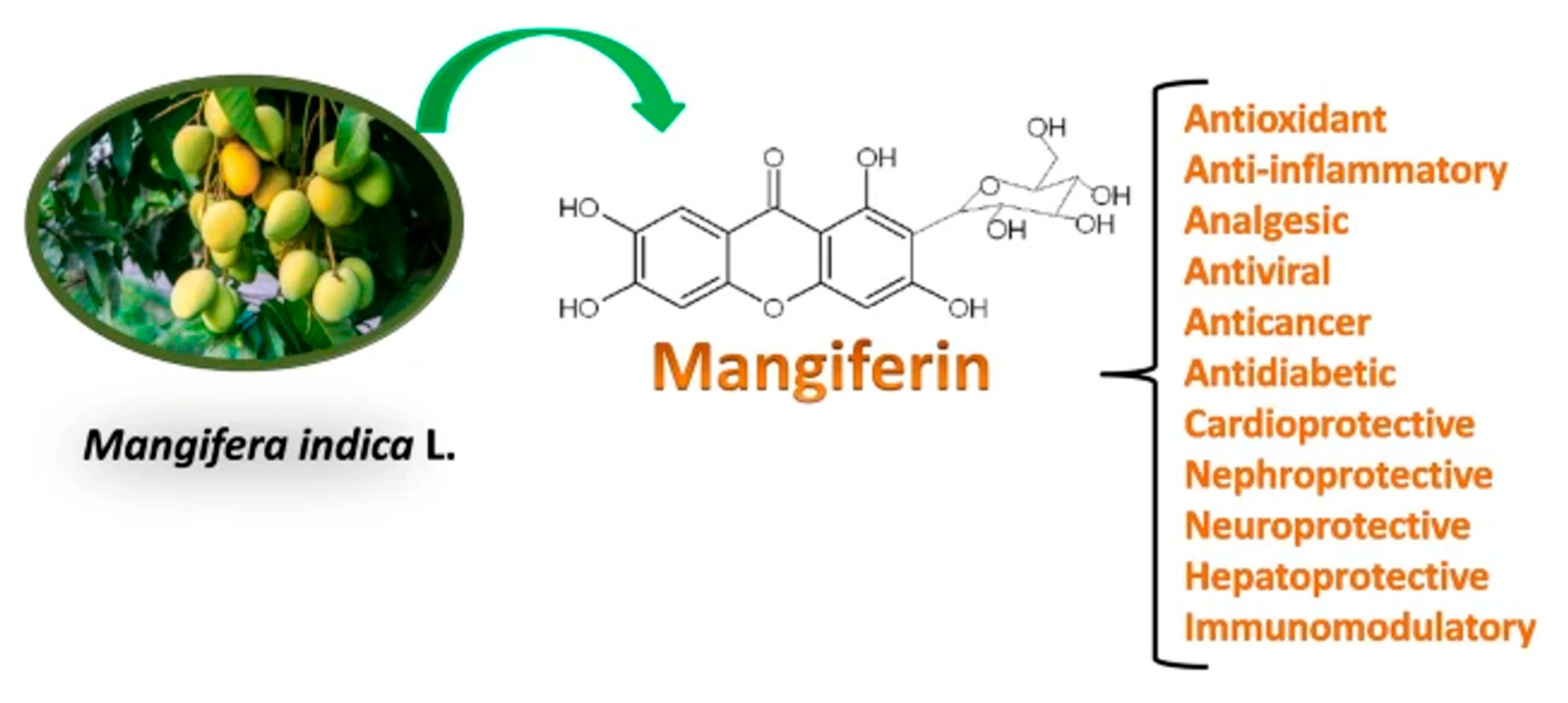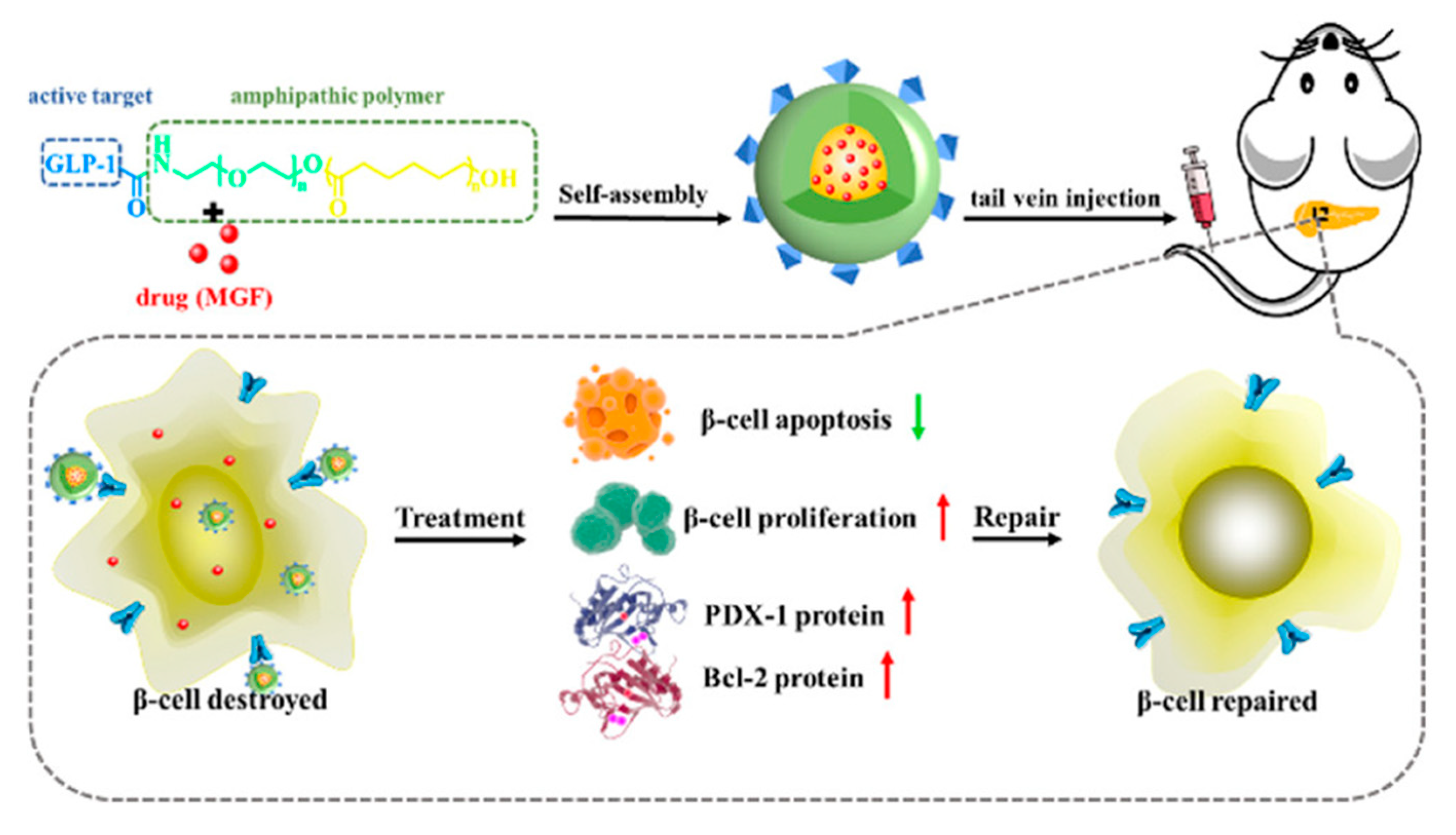Polymeric Matrices for Mangiferin Delivery: Ways to Enhance Bioavailability and Therapeutic Effect †
Abstract
1. Introduction

2. Mangiferin Delivery Systems
2.1. Polymeric Nanoparticles
2.2. Nanoparticles Based on Lipids
2.3. Micelles and Self-Assembled Particles
2.4. Gels and Emulsions
2.5. Polymer Films
3. Conclusions and Future Perspectives
Author Contributions
Funding
Institutional Review Board Statement
Informed Consent Statement
Data Availability Statement
Conflicts of Interest
References
- Dutta, T.K.; Yadav, S.K.; Chatterjee, A. Antibiotics as Feed Additives for Livestock: Human Health Concerns. Indian J. Anim. Health 2019, 58, 121. [Google Scholar] [CrossRef]
- Casey, J.A.; Tartof, S.Y.; Davis, M.F.; Nachman, K.E.; Price, L.; Liu, C.; Yu, K.; Gupta, V.; Innes, G.K.; Tseng, H.F.; et al. Impact of a Statewide Livestock Antibiotic Use Policy on Resistance in Human Urine Escherichia Coli Isolates: A Synthetic Control Analysis. Environ. Health Perspect. 2023, 131, 27007. [Google Scholar] [CrossRef]
- Simjee, S.; Ippolito, G. European Regulations on Prevention Use of Antimicrobials from January 2022. Braz. J. Vet. Med. 2022, 44, e000822. [Google Scholar] [CrossRef]
- Lee, J.Y.; Kim, H.; Moon, Y.; Kwak, S.; Kang, C.G.; Park, C.; Jo, J.; Kim, S.W.; Pal, K.; Kang, D.H.; et al. Enhancement of the Water Solubility and Antioxidant Capacities of Mangiferin by Transglucosylation Using a Cyclodextrin Glycosyltransferase. Enzyme Microb. Technol. 2022, 159, 110065. [Google Scholar] [CrossRef]
- Sarfraz, M.; Khan, A.; Batiha, G.E.S.; Akhtar, M.F.; Saleem, A.; Ajiboye, B.O.; Kamal, M.; Ali, A.; Alotaibi, N.M.; Aaghaz, S.; et al. Nanotechnology-Based Drug Delivery Approaches of Mangiferin: Promises, Reality and Challenges in Cancer Chemotherapy. Cancers 2023, 15, 4194. [Google Scholar] [CrossRef]
- Morozkina, S.N.; Nhung Vu, T.H.; Generalova, Y.E.; Snetkov, P.P.; Uspenskaya, M.V. Mangiferin as New Potential Anti-Cancer Agent and Mangiferin-Integrated Polymer Systems—A Novel Research Direction. Biomolecules 2021, 11, 79. [Google Scholar] [CrossRef]
- Baghel, M.; Baghel, I.; Kumari, P.; Bharkatiya, M.; Joshi, G.; Sakure, K.; Badwaik, H. Nano-Delivery Systems and Therapeutic Applications of Phytodrug Mangiferin. Appl. Biochem. Biotechnol. 2024, 196, 7429–7463. [Google Scholar] [CrossRef]
- Barakat, S.; Nasr, M.; Ahmed, R.F.; Badawy, S.; Mortada, N. Recent Formulation Advances of Mangiferin. Rev. Bras. Farmacogn. 2022, 32, 871–882. [Google Scholar] [CrossRef]
- Athipornchai, A.; Pabunrueang, P.; Trakulsujaritchok, T. Mangiferin Loaded Carrageenan/Chitosan Core-Shell Hydrogel Beads: Preparation, Characterization and Proposed Application. Food Hydrocoll. 2024, 147, 109394. [Google Scholar] [CrossRef]
- Razura-Carmona, F.F.; Pérez-Larios, A.; González-Silva, N.; Herrera-Martínez, M.; Medina-Torres, L.; Sáyago-Ayerdi, S.G.; Sánchez-Burgos, J.A. Mangiferin-Loaded Polymeric Nanoparticles: Optical Characterization, Effect of Antitopoisomerase I, and Cytotoxicity. Cancers 2019, 11, 1965. [Google Scholar] [CrossRef]
- Jain, R.; Tiwari, R.; Agrawal, O.P.; Shukla, A.K. Bioinspired Folic Acid-ADH-PLGA Polymeric Nanoparticles Loaded with Mangiferin and Piperine: A Promising Strategy for Targeted Delivery in Multidrug-Resistant Lung Cancer Cells. Asian J. Chem. 2023, 35, 2640–2650. [Google Scholar] [CrossRef]
- de Souza, J.R.R.; Feitosa, J.P.A.; Ricardo, N.M.P.S.; Trevisan, M.T.S.; de Paula, H.C.B.; Ulrich, C.M.; Owen, R.W. Spray-Drying Encapsulation of Mangiferin Using Natural Polymers. Food Hydrocoll. 2013, 33, 10–18. [Google Scholar] [CrossRef]
- Wang, H.; Shao, W.; Lu, X.; Gao, C.; Fang, L.; Yang, X.; Zhu, P. Synthesis, Characterization, and in Vitro Anti-Tumor Activity Studies of the Hyaluronic Acid-Mangiferin-Methotrexate Nanodrug Targeted Delivery System. Int. J. Biol. Macromol. 2023, 239, 124208. [Google Scholar] [CrossRef]
- Shaikenov, R.; Klimshina, V.; Generalova, Y.; Serbun, P.; Kosova, A.; Dorogov, M.; Morozkina, S.; Snetkov, P. Electrospun Hyaluronan-Based Nanofibers with Mangiferin: Preparation, Morphology, and Drug Release Kinetics. In Proceedings of the IOCBE 2024, Basel, Switzerland, 28 November 2024; p. 2. [Google Scholar]
- Samadarsi, R.; Dutta, D. Design and Characterization of Mangiferin Nanoparticles for Oral Delivery. J. Food Eng. 2019, 247, 80–94. [Google Scholar] [CrossRef]
- Chakraborty, P.; Das, A.; Chatterjee, S.; Bairagi, A.; Bhattacharya, H.; Bhattacharyya, C.; Chatterjee, N.; Sil, P.C.; Dewanjee, S. Formulation and Evaluation of Polymeric Nanoparticles to Improve in Vivo Chemotherapeutic Efficacy of Mangiferin against Breast Cancer. Naunyn Schmiedebergs Arch. Pharmacol. 2025. [Google Scholar] [CrossRef]
- Allaw, M.; Pleguezuelos-Villa, M.; Manca, M.L.; Caddeo, C.; Aroffu, M.; Nacher, A.; Diez-Sales, O.; Saurí, A.R.; Ferrer, E.E.; Fadda, A.M.; et al. Innovative Strategies to Treat Skin Wounds with Mangiferin: Fabrication of Transfersomes Modified with Glycols and Mucin. Nanomedicine 2020, 15, 1671–1685. [Google Scholar] [CrossRef]
- Khurana, R.K.; Bansal, A.K.; Beg, S.; Burrow, A.J.; Katare, O.P.; Singh, K.K.; Singh, B. Enhancing Biopharmaceutical Attributes of Phospholipid Complex-Loaded Nanostructured Lipidic Carriers of Mangiferin: Systematic Development, Characterization and Evaluation. Int. J. Pharm. 2017, 518, 289–306. [Google Scholar] [CrossRef]
- Foudah, A.I.; Ayman Salkini, M.; Alqarni, M.H.; Alam, A. Preparation and Evaluation of Antidiabetic Activity of Mangiferin-Loaded Solid Lipid Nanoparticles. Saudi J. Biol. Sci. 2024, 31, 103946. [Google Scholar] [CrossRef]
- Santonocito, D.; Vivero-Lopez, M.; Lauro, M.R.; Torrisi, C.; Castelli, F.; Sarpietro, M.G.; Puglia, C. Design of Nanotechnological Carriers for Ocular Delivery of Mangiferin: Preformulation Study. Molecules 2022, 27, 1328. [Google Scholar] [CrossRef]
- Khurana, R.K.; Gaspar, B.L.; Welsby, G.; Katare, O.P.; Singh, K.K.; Singh, B. Improving the Biopharmaceutical Attributes of Mangiferin Using Vitami E-TPGS Co-Loaded Self-Assembled Phosholipidic Nano-Mixed Micellar Systems. Drug Deliv. Transl. Res. 2018, 8, 617–632. [Google Scholar] [CrossRef]
- Wang, M.; Zhang, Z.; Huo, Q.; Wang, M.; Sun, Y.; Liu, H.; Chang, J.; He, B.; Liang, Y. Targeted Polymeric Nanoparticles Based on Mangiferin for Enhanced Protection of Pancreatic β-Cells and Type 1 Diabetes Mellitus Efficacy. ACS Appl. Mater. Interfaces 2022, 14, 11092–11103. [Google Scholar] [CrossRef] [PubMed]
- Pipattanawarothai, A.; Athipornchai, A.; Sripreechasak, P.; Trakulsujaritchok, T. Development of Polymeric Hydrogels for Potential Biomedical Applications. Burapha Sci. J. 2019, 24, 885–900. [Google Scholar]
- Meng, C.; Wei, W.; Wang, Y.; Zhang, K.; Zhang, T.; Tang, Y.; Tang, F. Study of the Interaction between Self-Assembling Peptide and Mangiferin and in Vitro Release of Mangiferin from in Situ Hydrogel. Int. J. Nanomedicine 2019, 14, 7447–7460. [Google Scholar] [CrossRef] [PubMed]
- Pleguezuelos-Villa, M.; Nácher, A.; Hernández, M.J.; Ofelia Vila Buso, M.A.; Ruiz Sauri, A.; Díez-Sales, O. Mangiferin Nanoemulsions in Treatment of Inflammatory Disorders and Skin Regeneration. Int. J. Pharm. 2019, 564, 299–307. [Google Scholar] [CrossRef]
- Chomchoei, N.; Leelapornpisid, P.; Tipduangta, P.; Sirithunyalug, J.; Sirithunyalug, B.; Samutrtai, P. Electrospray-Mangiferin Nanoparticles Gel: A Promising Agent for Sun and Age Defense. Cosmetics 2024, 11, 93. [Google Scholar] [CrossRef]
- Tohamy, H.A.S.; El-Sakhawy, M.; El-Masry, H.M.; Saleh, I.A.; AbdelMohsen, M.M. Preparation of Hydroxyethyl Cellulose/ Mangiferin Edible Films and Their Antimicrobial Properties. BMC Chem. 2022, 16, 113. [Google Scholar] [CrossRef]
- Boonnattakorn, R.; Chonhenchob, V.; Siddiq, M.; Singh, S.P. Controlled Release of Mangiferin Using Ethylene Vinyl Acetate Matrix for Antioxidant Packaging. Packag. Technol. Sci. 2015, 28, 241–252. [Google Scholar] [CrossRef]
- Boonnattakorn, R.; Sane, A.; Chonhenchob, V. Antioxidant Microemulsion-Based Ethylene Vinyl Acetate Film Containing Mangiferin and Surfactants. MATEC Web Conf. 2016, 67, 6101. [Google Scholar] [CrossRef]

| Main Formulation of Matrice | Mangiferin Concentrations | Type of the Cells Lines | Ref. |
|---|---|---|---|
| Carrageenan and chitosan | 2.5–10.0% | L929 and kidney epithelial cells | [9] |
| Poly(lactic-co-glycolic acid) and polyvinyl alcohol | 1.0–2.0% | BEAS 2B and HEPG2 | [10] |
| Folic acid-adipic dihydrazide-PLGA | 33.0–60.0% | A549 | [11] |
| Citric pectin/pumpkin pectin/chitosan | 10.0% | - | [12] |
| Hyaluronic acid and methotrexate | 13.0–28.0% | k7 and MC3T3-E1 | [13] |
| Hyaluronic acid | 4.0–20.0% | - | [14] |
| β-lactoglobulin | 22.0–22.5% |
Escherichia coli
Bacillus subtilis Staphylococcus aureus Lactobacillus acidophilus Lactobacillus rhamnosus | [15] |
| Lecithin, glycerol, propylene glycol and mucin | 5.0% | 3T3 | [17] |
| Phospholipon 90, lecithin, Labrafil M 2125 and Compritol 888 ATO | - | Caco-2 | [18] |
| Labrafil M 2130 CS | - | in vivo tests | [19] |
| Compritol 888 ATO and Miglyol 812 | 0.1% | fertilized hen eggs | [20] |
| Phospholipid 90G and poly(ethylene glycol) 200 | - | MCF-7 and MDA-MB-231 | [21] |
| Polyethyleneglycol-polycaprolactone and Glucagon-like peptide 1 | 20.0% | L929 and Min6 | [22] |
| Polyvinyl alcohol, gelatin and chitosan | 2.5% | Micrococus luteus Pseudomonas aeruginosa | [23] |
| RADA16-I | - | KYSE 30, DLD-1 and 293T | [24] |
| Lipoid ® S75, polysorbate 80, tocopherol and hyaluronic acid | 1% | in vivo tests | [25] |
| Hydroxyethyl cellulose | 2.5–10.0% | - | [27] |
| Ethylene vinyl acetate | 0.3% | - | [28] |
Disclaimer/Publisher’s Note: The statements, opinions and data contained in all publications are solely those of the individual author(s) and contributor(s) and not of MDPI and/or the editor(s). MDPI and/or the editor(s) disclaim responsibility for any injury to people or property resulting from any ideas, methods, instructions or products referred to in the content. |
© 2025 by the authors. Licensee MDPI, Basel, Switzerland. This article is an open access article distributed under the terms and conditions of the Creative Commons Attribution (CC BY) license (https://creativecommons.org/licenses/by/4.0/).
Share and Cite
Shaikenov, R.O.; Klimshina, V.I.; Morozkina, S.N.; Snetkov, P.P. Polymeric Matrices for Mangiferin Delivery: Ways to Enhance Bioavailability and Therapeutic Effect. Eng. Proc. 2025, 87, 78. https://doi.org/10.3390/engproc2025087078
Shaikenov RO, Klimshina VI, Morozkina SN, Snetkov PP. Polymeric Matrices for Mangiferin Delivery: Ways to Enhance Bioavailability and Therapeutic Effect. Engineering Proceedings. 2025; 87(1):78. https://doi.org/10.3390/engproc2025087078
Chicago/Turabian StyleShaikenov, Roman O., Vladislava I. Klimshina, Svetlana N. Morozkina, and Petr P. Snetkov. 2025. "Polymeric Matrices for Mangiferin Delivery: Ways to Enhance Bioavailability and Therapeutic Effect" Engineering Proceedings 87, no. 1: 78. https://doi.org/10.3390/engproc2025087078
APA StyleShaikenov, R. O., Klimshina, V. I., Morozkina, S. N., & Snetkov, P. P. (2025). Polymeric Matrices for Mangiferin Delivery: Ways to Enhance Bioavailability and Therapeutic Effect. Engineering Proceedings, 87(1), 78. https://doi.org/10.3390/engproc2025087078







